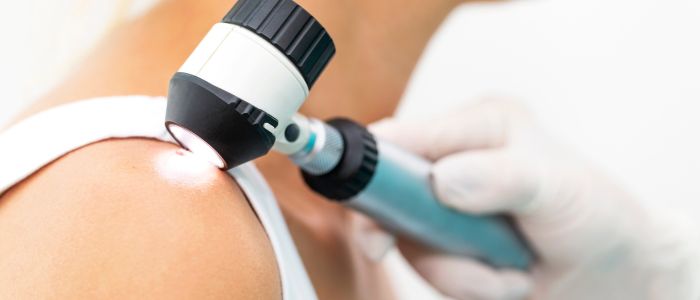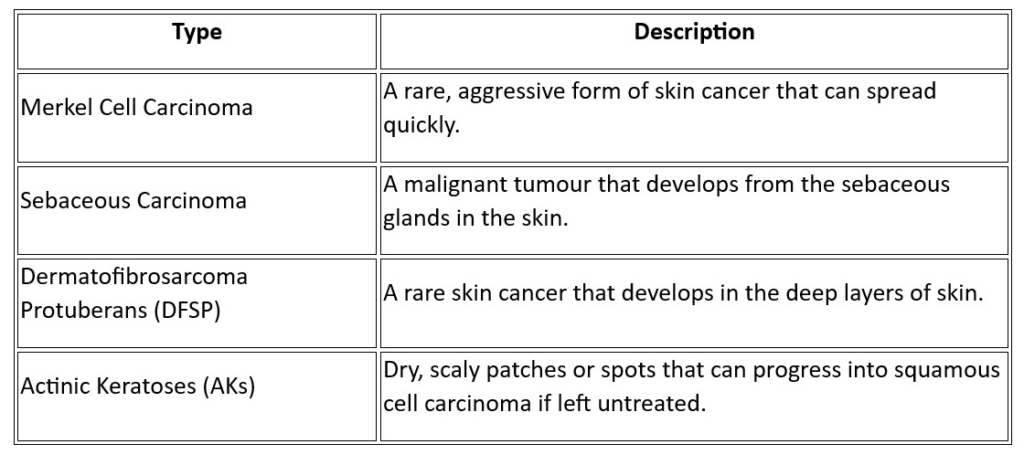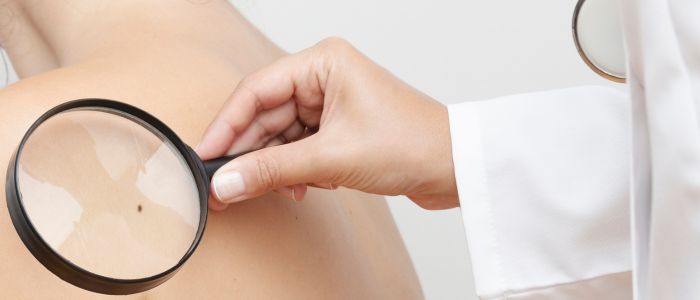
Table of Contents
- A Complex Review of Treatments for Skin Cancer
- Types of Skin Cancer
- Basal Cell Carcinoma (BCC)
- Squamous Cell Carcinoma (SCC)
- Melanoma
- Risk Factors for Skin Cancer
- Prevention Strategies
- Diagnosis of Skin Cancer
- Surgical Treatments for Skin Cancer
- Radiation Therapy
- Chemotherapy
- Photodynamic Therapy (PDT)
- Immunotherapy
- Targeted Therapy
- FAQs about Treatments and Solutions for Skin Cancer
- Further Reading about Skin Treatments at Cheshire Cosmetic Surgery
A Complex Review of Treatments for Skin Cancer
Skin cancer is one of the most common types of cancer globally, affecting millions of people each year. It primarily develops due to the uncontrolled growth of abnormal skin cells, which can be triggered by different factors including prolonged exposure to ultraviolet (UV) radiation from the sun or artificial sources such as tanning beds.
Skin cancer is broadly categorised into three main types: basal cell carcinoma (BCC), squamous cell carcinoma (SCC), and melanoma. BCC and SCC are often grouped together as non-melanoma skin cancers and are generally less aggressive, whereas melanoma is more likely to spread and can be life-threatening if not treated early.
Early detection of skin cancer increases the chances of successful treatment and reduces the risk of severe complications. This makes regular self-examinations and professional skin evaluations imperative.
In this post, Anca Breahna, a plastic and cosmetic surgeon with specialist knowledge in the field of skin cancer and its treatment, will provide key information regarding treatments and solutions for skin cancer.
Types of Skin Cancer
There are several types of skin cancer, each with its own characteristics and risk factors. Let’s explore the most common forms:
Basal Cell Carcinoma (BCC)
BCC is the most prevalent type, accounting for around 75% of non-melanoma skin cancers. It develops from the basal cells in the deepest part of the skin’s outer layer (epidermis). While rare for BCC to spread to other parts of the body, it’s possible to have multiple occurrences. Most often diagnosed in middle-aged or older individuals, BCCs typically appear on sun-exposed areas.
Squamous Cell Carcinoma (SCC)
Representing approximately 23% of non-melanoma skin cancers, SCCs are generally faster-growing than BCCs. They often develop on sun-exposed skin and can, in rare cases, spread to deeper layers of skin and nearby lymph nodes. SCCs most commonly affect older adults.
Melanoma
Melanoma is the deadliest form of skin cancer, developing from melanocytes (pigment-producing cells). It can arise within an existing mole or appear as a new dark spot on the skin. Early detection is crucial for effective treatment and improved outcomes.
Other less common types include:
Remember, early detection and regular skin checks are essential for effective management of any type of skin cancer.
Risk Factors for Skin Cancer
Several factors can increase your risk of developing skin cancer. The two main categories of risk factors include genetic predispositions and environmental influences.
Genetic factors play a significant role in skin cancer susceptibility. If you have a family history of skin cancer, especially melanoma, your risk may be higher. This genetic link suggests that certain DNA mutations associated with skin cancer can be inherited. Additionally, people with fair skin, light hair, and blue or green eyes have less melanin, which means less natural protection against UV radiation, increasing their risk.
Environmental influences primarily involve exposure to UV radiation. This is the most preventable risk factor for skin cancer. Prolonged exposure to the sun without adequate protection, such as sunscreen and protective clothing, significantly increases the risk. Additionally, using tanning beds exposes your skin to intense UV radiation, which can also lead to skin cancer. Living in areas with strong sunlight year-round or at high altitudes, where the sun’s rays are more direct, further elevates your risk.
To reduce your risk, it’s advisable to limit sun exposure during peak sun hours, usually between 10 a.m. and 4 p.m., and always wear sunscreen with a high SPF rating. Reapplying sunscreen every two hours or after swimming or sweating, and wearing protective clothing such as hats and long sleeves, are effective strategies.
Prevention Strategies
To reduce your risk of skin cancer consider implementing the following preventive measures:
- Limit Sun Exposure: Avoid direct sunlight during peak hours (typically between 10 a.m. and 4 p.m.) and seek shade whenever possible.
- Wear Protective Clothing: Cover up with lightweight, long-sleeved shirts, pants, hats, and sunglasses when outdoors to shield your skin from harmful UV rays.
- Apply Sunscreen Regularly: Use a broad-spectrum sunscreen with an SPF of 30 or higher, and reapply it every two hours, or more frequently if swimming or sweating.
- Avoid Indoor Tanning: Steer clear of indoor tanning beds and lamps, as they emit UV radiation that can increase your risk of skin cancer.
- Perform Regular Self-Exams: Conduct monthly skin self-examinations to check for any new or changing moles, freckles, or spots, and promptly report any concerns to your dermatologist.
- Schedule Professional Skin Checks: Visit a dermatologist annually for a complex skin examination to detect any potential signs of skin cancer early on.
Diagnosis of Skin Cancer
Early diagnosis of skin cancer can significantly improve the outcome and simplify the treatment process. If you have identified potential symptoms of skin cancer, the next step is to undergo a professional evaluation. Here’s what you can expect during the diagnostic process:
Physical Examination
Anca will start with a thorough examination of your skin to check for any unusual moles, growths, or lesions. She will check the size, shape, colour, and texture of any suspicious areas. If you have a history of sun exposure or a family history of skin cancer, make sure to share this information as it can assist in a more targeted examination.
Biopsy Techniques
If a lesion appears suspicious, Anca might recommend a biopsy, the only definitive way to diagnose skin cancer. This involves removing all or part of the growth for microscopic examination. There are several types of biopsies:
- Excisional biopsy: The entire growth is removed; commonly used when melanoma is suspected.
- Incisional biopsy: Only a portion of the growth is removed; used when the lesion is too large to be entirely removed initially.
- Shave biopsy: The top layer of the skin is shaved off; often used for superficial skin layers.
- Punch biopsy: A circular tool is used to remove a small core of skin, including deeper layers.
Imaging Tests
For advanced cases, especially if melanoma is diagnosed and there is a concern it has spread, imaging tests like X-rays, CT scans, MRI scans, or PET scans might be recommended to determine the extent of the spread and plan appropriate treatment strategies.
Surgical Treatments for Skin Cancer
Surgical intervention is a common and effective method for treating skin cancer, especially when detected early. The type of surgery depends on the type and stage of cancer, its size, and location. Here’s a closer look at the primary surgical options employed by Anca:
- Excisional Surgery: This is the most straightforward type of surgery where the cancerous tissue and a margin of healthy tissue around it are cut out of the skin. This margin is tested to ensure no cancer cells remain. For a closer look at how these procedures are performed and what to expect, see our blog on the removal of cancerous skin lesions. Excisional surgery is commonly used for both melanoma and non-melanoma skin cancers and is performed under local anaesthetic.
- Cryosurgery: This method uses liquid nitrogen to freeze and destroy abnormal cells. It is often used for pre-cancerous conditions and small, early-stage cancers located on the surface of the skin. Cryosurgery is less invasive than other surgical methods and usually leaves minimal scarring.
Each surgical approach has its own set of advantages, making it suitable for different situations. Excisional surgery might offer high cure rates for localised skin cancers. Cryosurgery, while less invasive, might be more suitable for patients who are looking for a simpler procedure with a quicker recovery time.
Radiation Therapy
Radiation therapy is a treatment option for skin cancer that involves using high-energy rays to target and destroy cancer cells. It is often used when surgical methods are not viable or as an adjunct treatment to surgery to ensure all cancerous cells are eradicated.
Radiation therapy can be an effective treatment for both basal cell and squamous cell carcinomas, particularly in the early stages. It’s also sometimes used for more advanced melanomas, especially when they have spread to other parts of the body.
Chemotherapy
Chemotherapy involves the use of drugs to kill cancer cells, and it can be employed in various ways to treat skin cancer, depending on the stage and type of the disease. Chemotherapy can be a standalone treatment or part of a combination approach that includes surgery and radiation. The effectiveness of chemotherapy can vary widely, with factors such as the type of skin cancer and its stage playing critical roles in determining the best chemotherapy regimen.
Photodynamic Therapy (PDT)
Photodynamic Therapy (PDT) is a treatment that combines light-sensitive medication with a light source to destroy cancer cells. It is particularly used for treating superficial skin cancers and pre-cancerous growths, such as actinic keratosis.
The treatment involves applying a light-sensitive drug, known as a photosensitiser, to the affected area of the skin. This drug is left to be absorbed by the skin cells for several hours or days. Once absorbed, the area is then exposed to a specific wavelength of light. This light activates the photosensitiser, producing a form of oxygen that kills nearby cancer cells. The treatment effectively targets and destroys abnormal cells while sparing the surrounding healthy tissue.
PDT is effective for treating certain types of skin cancers that are confined to the outer layers of the skin. It has the advantage of being less invasive than surgery and typically results in minimal scarring. PDT is also useful for treating large areas of the skin uniformly, which can be difficult with other treatments. However, it is less effective against thicker skin cancers or those that have penetrated deeper into the skin. Another limitation is the requirement for the treatment area to be exposed to light, which means it is not suitable for cancers in certain locations.
PDT is generally well-tolerated, with the most common side effects being redness, swelling, and sensitivity to light in the treated area. These effects usually resolve within a few days. Since the treatment targets only the cells that absorb the photosensitiser, it can be repeated if necessary without damaging the skin permanently.
Immunotherapy
Immunotherapy represents a revolutionary approach in the treatment of skin cancer, particularly for melanoma, which has traditionally been difficult to treat in advanced stages. This method leverages the body’s immune system to identify and destroy cancer cells.
Targeted Therapy
Targeted therapy is a form of cancer treatment that uses drugs or other substances to precisely identify and attack cancer cells, usually while doing little damage to normal cells. This treatment is particularly applicable for skin cancers that have specific genetic mutations.
FAQs about Treatments and Solutions for Skin Cancer

What are the risks associated with untreated skin cancer?
Untreated skin cancer can lead to serious health issues, including significant local damage and disfigurement. In more aggressive forms like melanoma, the cancer can spread (metastasize) to other parts of the body, which can be fatal. Delaying treatment can allow the cancer to grow and reach a stage where it becomes more difficult to treat and may require more extensive surgical intervention or more aggressive systemic treatments.
Can skin cancer treatments affect my daily life?
Yes, skin cancer treatments can impact your daily activities, especially during the recovery periods from surgeries or during ongoing therapies like radiation or chemotherapy. Side effects such as fatigue, pain, and skin sensitivity might limit your ability to perform routine tasks. However, many patients are able to manage these effects with proper medical guidance and continue with most of their everyday activities.
Are there new treatments in development for skin cancer?
Yes, research into skin cancer treatments is ongoing, and new therapies are continuously being developed. Some of the promising areas include advanced targeted therapies, new immunotherapy agents, and gene therapy techniques.
Medical References about Treatments and Solutions for Skin Cancer
- Skin Cancer Treatment – National Cancer Institute: https://www.cancer.gov/types/skin/patient/skin-treatment-pdq
- Skin cancer – Diagnosis and treatment – Mayo Clinic: https://www.mayoclinic.org/diseases-conditions/skin-cancer/diagnosis-treatment/drc-20377608
- Treatment for skin cancer – Cancer Research UK: https://www.cancerresearchuk.org/about-cancer/skin-cancer/treatment
- Skin Cancer: Symptoms, Types & Treatment – Cleveland Clinic: https://my.clevelandclinic.org/health/diseases/15818-skin-cancer
- Treatment for non-melanoma skin cancer – NHS: https://www.nhs.uk/conditions/non-melanoma-skin-cancer/treatment/
Further Reading about Skin Treatments at Cheshire Cosmetic Surgery
- Read more about Why You Should See a Plastic Surgeon for Minor Skin Surgery, Lumps and Bumps
- Read more about Recovery after Skin Tag Removal
- Read more about Where to Get Skin Relaxing Injections in Chester
- Read more about What Does Skin Cancer Look Like?
- Read more about Skin Cancer & Mole Surgery At Chester Cosmetic Surgery








